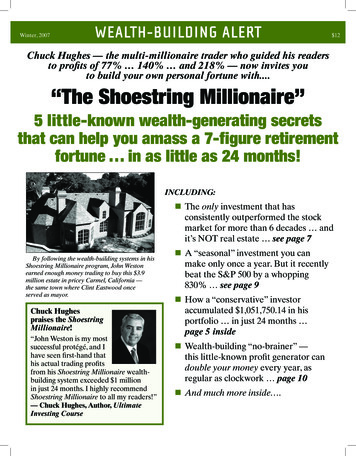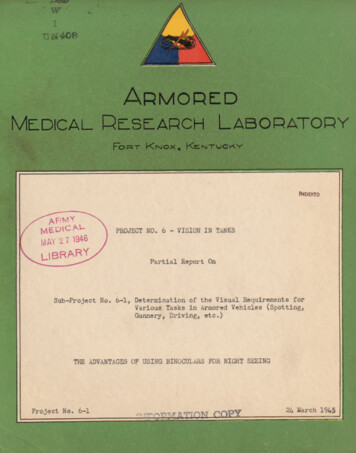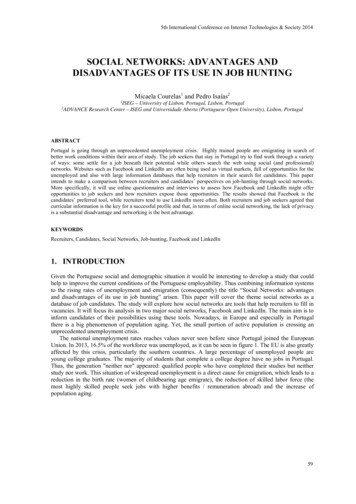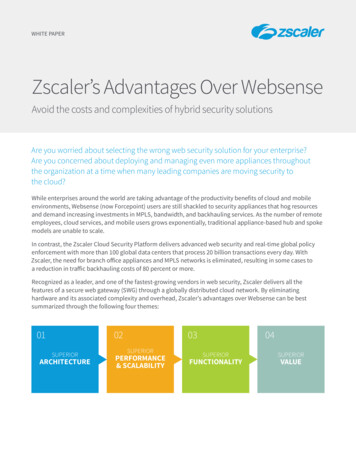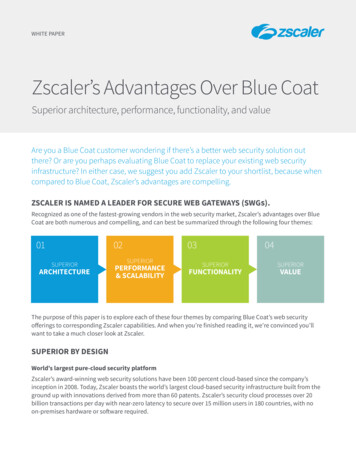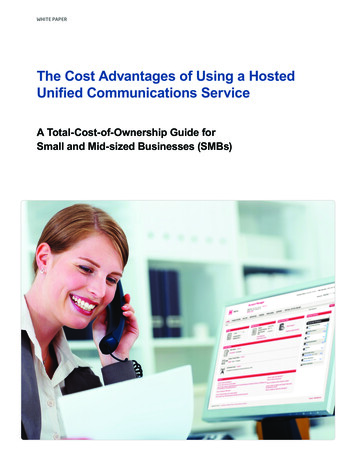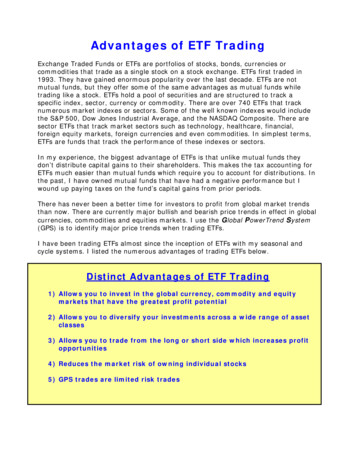
Transcription
Advantages of ETF TradingExchange Traded Funds or ETFs are portfolios of stocks, bonds, currencies orcommodities that trade as a single stock on a stock exchange. ETFs first traded in1993. They have gained enormous popularity over the last decade. ETFs are notmutual funds, but they offer some of the same advantages as mutual funds whiletrading like a stock. ETFs hold a pool of securities and are structured to track aspecific index, sector, currency or commodity. There are over 740 ETFs that tracknumerous market indexes or sectors. Some of the well known indexes would includethe S&P 500, Dow Jones Industrial Average, and the NASDAQ Composite. There aresector ETFs that track market sectors such as technology, healthcare, financial,foreign equity markets, foreign currencies and even commodities. In simplest terms,ETFs are funds that track the performance of these indexes or sectors.In my experience, the biggest advantage of ETFs is that unlike mutual funds theydon’t distribute capital gains to their shareholders. This makes the tax accounting forETFs much easier than mutual funds which require you to account for distributions. Inthe past, I have owned mutual funds that have had a negative performance but Iwound up paying taxes on the fund’s capital gains from prior periods.There has never been a better time for investors to profit from global market trendsthan now. There are currently major bullish and bearish price trends in effect in globalcurrencies, commodities and equities markets. I use the Global PowerTrend System(GPS) is to identify major price trends when trading ETFs.I have been trading ETFs almost since the inception of ETFs with my seasonal andcycle systems. I listed the numerous advantages of trading ETFs below.Distinct Advantages of ETF Trading1) Allows you to invest in the global currency, commodity and equitymarkets that have the greatest profit potential2) Allows you to diversify your investments across a wide range of assetclasses3) Allows you to trade from the long or short side which increases profitopportunities4) Reduces the market risk of owning individual stocks5) GPS trades are limited risk trades
Diversified Global MarketsExchange Traded Funds now cover a wide range of asset classes including fixedincome, energy, currency, commodity and equity. A sampling of some of the differenttypes of ETF asset classes follows.Currency ETFs Australian Dollar Trust ETF (FXA) British Pound Sterling Trust ETF (FXB) Canadian Dollar Trust ETF (FXC) Euro Trust ETF (FXE) Japanese Yen Trust ETF (FXY) Mexican Peso Trust ETF (FXM) Swedish Krona Trust ETF (FXS) Swiss Franc Trust ETF (FXF) EUR/USD Exchange Rate ETN (ERO) GBP/USD Exchange Rate ETN (GBB) JPY/USD Exchange Rate ETN (JYN) US Dollar Index Bearish Fund (UDN) US Dollar Index Bullish Fund (UUP)Commodity ETFsMarket Vectors Coal (KOL)Grains Total Return ETN (JJG)UltraShort Basic Materials ETF (SMN)DB Agriculture Fund (DBA)Market Vectors Steel (SLX)Copper Total Return ETN (JJC)Energy Total Return ETN (JJE)
Industrial Metals Total Return ETN (JJM)Natural Gas Total Return ETN (GAZ)Crude Oil Total Return ETN (OIL)Gold Trust ETF (IAU)Silver Trust ETF (SLV)Base Metals Fund (DBB)Basic Materials Sector Fund (DBN)Precious Metals Fund (DBP)Silver Fund (DBS)Oil Fund (USO)U.S. Basic Materials Sector Index Fund (IYM)Materials Sector Fund (XLB)Equity ETFsEmerging Markets 50 ADR Index ETF (ADRE)Emerging Markets Portfolio ETF (PXH)MSCI BRIC Index Fund (BKF)Emerging Markets Index Fund (EEM)Market Vectors Russia ETF (RSX)Short MSCI EAFE ETF (EFZ)UltraShort MSCI Emerging Markets ETF (EEV)BRIC 40 ETF (BIK)Emerging Europe ETF (GUR)Emerging Markets ETF (VWO)Asia Pacific Portfolio ETF (PUA)Chindia Index Fund (FNI)
Asia 50 Index Fund (AIA)Pacific ETF (VPL)China 25 Index Fund (FXI)Hong Kong Index Fund (EWH)UltraShort FTSE/Xinhua China 25 ETF (FXP)EURO STOXX 50 ETF (FEZ)Europe Portfolio ETF (PEH)Europe Portfolio ETF (PEF)MSCI EMU Index Fund (EZU)European ETF (VGK)Trading Markets with the Best Profit OpportunitiesOne of the big advantages of ETFs is that they allow you to trade global markets withthe best profit opportunities. This year US stocks have been very volatile. Theincreased volatility has made profiting from the long or short side very difficult. Thestock price graphs that follow for Alpha Natural Resources (ANR), Walter Industries(WLT) and Cleveland Cliffs (CLF) are examples of the volatile price moves in US stocks(charts courtesy of Yahoo Finance).
Volatile US Stocks
The percent gains and losses for Cleveland Cliffs stock over the past 7 weeks arelisted below:28.9%33.8%41.3%24.0%33.3%gain followed by aloss followed by again followed by aloss followed by againThe net result of these volatile moves was that the price CLF stock was virtuallyunchanged over the 7 week period. If you purchased CLF stock or options you wouldhave been “whipsawed” by the volatile moves. If you purchased a CLF put option, thevalue of the put would have decreased dramatically during the 28.9%, 41.3% and33.3% gains in CLF stock. And the value of a call option would have decreaseddramatically during the 33.8% and 24.0% losses in CLF stock. On any given day, theprice of a US stock can increase or decrease 10% to 20% in one day, making profitsfrom the long or short side very difficult.Global Markets with Clearly Defined TrendsIn contrast to the volatile price moves in US stocks, over the same time period mostglobal markets have experienced clearly defined, consistent trends. The price graphsthat follow show that these four global markets were in clearly defined down trendsand presented much better profit opportunities from short positions than US stockswhich were very volatile over the same time period. These examples demonstrate thatGlobal ETFs allow traders to trade markets with the best profit opportunities. The GPShas allowed me to take full advantage of the profit opportunities available in theseglobal markets buy purchasing short ETFs and put options which profit from thedecline in price of their underlying ETF. On balance, a short position in a global ETFcurrently represents a much better trading opportunity than a long or short position inthe volatile US market (charts courtesy of Yahoo Finance).Emerging Markets Index
South Korea IndexAustralia IndexRussia Index
Global Markets Offer More Profit OpportunitiesETFs allow you to trade global markets with the best profit opportunities. Many globalequity, currency and commodity markets offer much better returns than the US stockmarket. Many global economies are growing at a much faster rate than the U.S.economy and as a result global corporate profits are also growing at a faster rate. Theinfrastructure build-out in developing countries is leading to strong demand forenergy, basic materials, bank financing and wireless communications resulting inrecord corporate profits and price gains for many global stocks. The table belowcompares the return for the U.S. broad based S&P 500 Index to returns for a samplingof global stock markets over the two year period from 10/26/05 through 10/26/07.2-Year Return Comparisons Global Stock MarketsVersus S&P 500 Index 10/26/05 – 10/26/07S&P 500 Index29%iShares Brazil175%Emerging Markets114%iShares China268%iShares Singapore111%The price chart below compares the price movement for the iShares China Fund to theS&P 500 Index over the same two year period from October 2005 through October2007. The iShares China Fund out performed the S&P 500 Index by more than a 9 to1 margin (chart courtesy of MSN.com).2-Year Price Chart iShares China versus S&P 500 IndexiShares China
ETF Option Produces 130% Return Over 6 Week PeriodMy brokerage account Profit/Loss Report below shows a 23,502.75 profit whichtranslates to a 130% return for the Emerging Market ETF option over a 6 week period.The GPS Option Strategies I used to take this trade will be covered in Chapter 5.The price graph that follows compares the price action of the Emerging Market ETF tothe S&P 500 Index over the 6 week holding period for my option trade. The EmergingMarket ETF allowed me to trade a global market with better profit opportunities thanthe US markets (chart courtesy of MSN.com).Emerging Market ETF versus the S&P 500 Index over 6 Week Period
Diverse Asset AllocationETF trading allows you to diversify your investments across a wide range of globalasset classes including fixed income, foreign currencies, energy, precious metals,commodities and foreign equities. The non-correlation of investment returns betweenthese various asset classes allows you to reduce portfolio risk and smooth out yourinvestment returns. When you invest in non-correlated asset classes, a loss in oneasset class will normally be off set by a profit in a different asset class which reducesportfolio risk.Asset allocation should be the foundation of every sound investment portfolio. It is along term plan strategically designed to profit during any type of market. With ETFsnot only can you diversify across asset classes but you can take short positions aswell. There is always a bear market somewhere! This greatly increases the benefits ofasset allocation.According to the Financial Analysts Journal, asset allocation accounts for 90% of thetotal return of a diversified investment portfolio over the long term. This finding isbased on two sophisticated studies of the long-term performance of pension funds.The studies found that which stock or bond you pick isn't so important. What mattersover the long run is how you mix your assets among stocks, bonds, and commodities.Trading from Long or Short Side with Limited RiskOne of the great advantages of ETF trading is that it allows you to take both long andshort positions with limited risk. Unlike short selling, there are short or inverse ETFsthat allow you to short a market sector without actual short selling. Short selling ishigh risk and can result in margin calls if your short stock increases in price. You arealso responsible for paying dividends when you are short a stock. Short or inverseETFs are limited risk trades and you can’t lose more money than you invest. This is avery important distinction especially with the current volatile markets. If you are ashort seller, an adverse market move can wipe out your trading account and result inmargin calls requiring you to wire money to you broker to cover losses.Reducing Market RiskETFs consist of baskets of stocks that track a market sector. Owning an ETF instead ofindividual stocks can reduce risk. Individual stocks are always susceptible to marketrisk with unfavorable news or earnings reports that are stock specific. For example,the drug company Bristol Myers recently reported disappointing earnings and thestock was pummeled losing 23% of its value over a short period of time. Bristol Myersis part of the Pharmaceuticals HLDRS ETF and you can see from the price graphs thatfollow that over the same period of time the drop in Bristol Myers stock had littleeffect on the Pharmaceuticals HLDRS ETF which went on to make new high prices.This is a good example of how an ETF was much less susceptible to the market riskassociated with owning individual stocks.
Bristol Myers Price GraphPharmaceutical HLDRS ETF over Same Time Period
All GPS Trades are Limited Risk TradesThe GPS Trading Program utilizes the Major Trend Strategy and Short Term TrendStrategy to identify buy and sell signals in the global currency, commodity and equitymarkets. Four types of trades are used:1) Purchasing Long and Short ETFs2) Purchasing ETF Call and Put Options3) ETF Buy Writes4) ETF Bullish and Bearish Option SpreadsAll of the GPS strategies utilize limited risk trades. With limited risk trades the mostyou can lose is your initial investment regardless of adverse market moves. Limitedrisk trading is absolutely essential when trading volatile markets. You won’t receive a‘margin call’ from your broker or be asked to add funds to your brokerage account toavoid the forced liquidation of your positions.High Risk InvestmentsThe investments listed in the table below are what I categorize as ‘high risk’investments because you can lose more than your initial investment. An adversemarket move could wipe out your initial investment and could trigger a margin callthat would require you to add funds to your account. You would be legally liable topay back any and all losses that are sustained in your brokerage account. It onlytakes one unexpected overnight world event to wipe out a highly leveraged tradingaccount.High Risk InvestmentsInvestmentFutures TradingForex TradingShorting StocksBuying Stocks on MarginSelling Uncovered or ‘Naked’ OptionsPut SellingFutures trading usually involves 10 to 1 or 20 to 1 leverage. Forex trading can involve100 to 1 or even 200 to 1 leverage. It doesn’t take much of an adverse market movefor you to lose all of the cash in your account and worse yet owe your broker moneyin a margin call. You may think the odds are low that this could happen to you but aswe used to say in the Air Force “Sierra Hotel”! It can happen. It only has to happenonce and you are out of the game.
The # 1 Rule of TradingNever Put Yourself in a Position to Lose More Money than You InvestLehman Brothers, Bear Sterns and AIG did not go bankrupt because there was a 5%default rate in mortgages. A 5% default rate could easily be absorbed with 1 to 1leverage. They went bankrupt because they were highly leveraged and risked moremoney than they invested. The world financial system collapsed because the # 1 Ruleof Trading was violated. Limited risk trading is essential for your trading success.After taking a good look at ETFs, one would be foolish not to place them in theirinvestment portfolio. ETFs give you the power to invest in markets that have thegreatest profit potential and the ability to diversify your investments across a widerange of asset classes. They provide you with the opportunity to trade
Advantages of ETF Trading . Exchange Traded Funds or ETFs are portfolios of stocks, bonds, currencies or commodities that trade as a single stock on a stock exchange. ETFs first traded in 1993. They have gained enormous popularity over the last decade. ETFs are not mutual funds, but they offer some of the same advantages as mutual funds while trading like a stock. ETFs hold a pool of .

